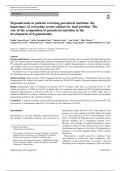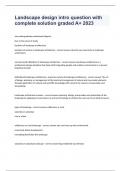European Journal of Clinical Nutrition
https://doi.org/10.1038/s41430-017-0026-5
ARTICLE
Hyponatremia in patients receiving parenteral nutrition: the
importance of correcting serum sodium for total proteins. The
role of the composition of parenteral nutrition in the
development of hyponatremia
Emilia Gómez-Hoyos1 Silvia Fernández-Peña1 Martín Cuesta2 Ana Ortolá1 Pilar Matía 2
● ● ● ● ●
Natalia Pérez-Ferre2 Daniel De Luis1 Alfonso Calle-Pascual2 Miguel Ángel Rubio2 Isabelle Runkle-De la Vega2
● ● ● ●
Received: 31 March 2017 / Revised: 31 July 2017 / Accepted: 21 September 2017
© Macmillan Publishers Limited, part of Springer Nature 2017
Abstract
Background/objectives Hyponatremia is the most common electrolyte disorder, and is associated with high-morbimortality
rates. The true prevalence of hyponatremia in patients on parenteral nutrition (PN) is unknown, and the relationship between
PN composition and development of hyponatremia has yet to be studied. Hypoproteinemia, a common finding in patients
receiving PN, induces an overestimation of serum sodium (SNa) levels, when using indirect electrolyte methodology. Thus,
SNa should be corrected for serum total protein levels (TP).
The objective was to accurately determine the prevalence of hyponatremia (indirect SNa corrected for PT) and evaluate
the relationship between the composition of PN and the development of hyponatremia.
Subjects/methods Medical records of 222 hospitalized patients receiving total PN during a 7-month period were reviewed.
Composition of PN, indirect SNa-mmol/l-, and SNa corrected for TP (SNa-TP)-mmol/l-, both upon initiation and during PN
administration, were analyzed.
Results Hyponatremia (SNa < 135 mmol/l) was present in 81% of subjects when SNa was corrected for TP, vs. 43%
without correction (p = 0.001). In total 64% of patients that were eunatremic upon initiation of PN developed hyponatremia
during PN administration, as detected by SNa-TP, vs. 28% as detected by uncorrected SNa (p < 0.001). There were no
significant differences in volume, osmolarity, sodium or total osmols administered in PN between patients who developed
hyponatremia and those who remained eunatremic.
Conclusions A majority of patients receiving PN present hyponatremia, when indirect SNa levels are corrected for TP. The
development of hyponatremia during PN is not related to the composition of the PN.
Introduction hyponatremia ranges from 30 to 42% when defined as the
presence of a serum sodium level (SNa) below 136 mmol/l
Hyponatremia is the most frequently encountered electro- [1, 2], with a prevalence of 19.7% when defined as a SNa
lyte disorder in hospitalized patients. The prevalence of below 135 mmol/l [3]. Hyponatremia is associated with an
elevated mortality rate in hospitalized patients [3–5].
However, active therapy of marked hyponatremia reduces
mortality to a third [1]. Thus, detection and correct volemic
* Emilia Gómez-Hoyos
emiliagomezhoyos@gmail.com classification and diagnosis of the cause of hyponatremia is
important, as it permits adequate therapy of this common
1
Endocrinology and Nutrition Department, Pharmacy Department, disorder [6].
Hospital Clínico Universitario de Valladolid-IEN, Facultad de Hyponatremia is usually caused by a reduction in the
Medicina Universidad de Valladolid, Valladolid, Spain
renal capacity to excrete free water (antidiuresis). This
2
Endocrinology and Nutrition Department, CIBERDEM, Hospital antidiuresis is due to the presence of “normal” or elevated
Clínico San Carlos- IdISSC, Facultad de Medicina Universidad
Complutense, Madrid, Spain
circulating levels of arginine vasopressin (AVP), the human
, E. Gómez-Hoyos et al.
antidiuretic hormone (ADH), levels that are not suppressed triglyceride levels, and TP must be taken into account to
by a lowering of plasma osmolality [7]. This non-osmotic accurately detect and assess hyponatremia.
AVP secretion, combined with increased oral or intravenous The first aim of this study was to evaluate the true pre-
fluid administration, induces a decrease in plasma osmol- valence of hyponatremia in patients receiving PN, correct-
ality, with the development or exacerbation of prior hypo- ing SNa as indicated above. The second aim was to
natremia [8]. Thus, hospitalized patients are at increased ascertain whether there is relationship between the compo-
risk for hyponatremia [9]. Parenteral nutrition (PN) patients, sition of the PN formula and the development or worsening
given the increase in intravenous fluids intrinsic to this of hyponatremia.
therapy, should be at an increased risk as well.
PN is indicated in patients that need nutritional support,
and in whom the gastrointestinal (GI) tract cannot be used, Methods
often due to major GI surgery (cancer, GI obstruction, or
ischemia and so on), or due to other GI disorders such as Study design
pancreatitis, resistant vomiting, diarrhea [10, 11]. In these
disorders, the development of the Syndrome of Inap- Observational, retrospective analytical study. This study
propriate Antidiuretic Hormone Secretion (SIADH) is fre- was approved by the Ethics Committee of the Hospital
quent. Furthermore, physiological non-osmotic stimuli of Clínico San Carlos, Madrid, Spain.
AVP secretion, such as pain, and nausea, are often present.
In this context, the increase in intravenous fluid therapy Population studied
caused by PN can induce a descent in SNa. Furthermore,
patients receiving PN can also present an increase in The study included all patients receiving total PN as indi-
extrarenal sodium loss, secondary to fever, fistulae, drai- cated by the Nutrition Unit of the Hospital Clínico San
nage, as well as to direct GI loss. Carlos (Madrid, Spain) between November 1st 2011 and
To correctly assess natremia, SNa must be corrected for June 1st 2012. Patients in Intensive Care units, below 18
glycemia, hypertriglyceridima and total proteins (TP). years of age, pregnant women, and patients receiving sup-
Hyperglycemia induces translocational hyponatremia, and plementary PN were excluded.
SNa levels must be adjusted for serum glucose levels [12].
Marked hypertriglyceridemia induces pseudohyponatremia, Data collection
and triglyceride levels higher than 400 mg/dl should be
detected. The method used to determine electrolyte serum Data were registered on the PN database of the Nutrition
levels must be taken into account. Many hospitals use Unit, as well as on the hospital's computer databases
automated indirect electrolyte serum methodology (IEM) to (laboratory and medical records). Patient data collected
measure SNa, giving results as a function of total serum included gender, age, principal diagnosis (CIE-9-MC),
volume, not distinguishing the solid and liquid fractions. Charlson co-morbility index, weight, height, Body Mass
Direct electrolyte measurement (DEM) determines only the Index (BMI), date of detection of hyponatremia, dates of
concentration of sodium in the liquid fraction. Thus, var- initiation and discontinuation of PN, indication for PN,
iations in TP will directly influence SNa as measure by composition of PN (energy in kcal, volume in ml, sodium
IEM, whereas DEM is more precise [13]. In patients will and potassium in mEq, glucose in grams, proteins in grams,
low TP, with an increase in the serum liquid fraction, IEM nitrogen in grams, lipids in grams, osmolarity in mOsm/l,
has been found to give falsely high sodium levels, with the osmols in mOsm). Osmols were calculated as the sum of
opposite occurring in patients with hyperproteinemia [14]. urea (50 mmol of urea for every 10 g of proteins adminis-
The former has been found to be more frequent in hospi- tered), sodium chloride (NaCl) and potassium chloride
talized patients than the latter, with up to 85% of critical (KCl), with 1 mOsm for every mmol of urea, and 2 mmol
patients presenting low TP [15]. In fact, hyponatremia was for every mmol of NaCl and of KCl [17]. Laboratory tests:
not detected by IEM in 27% of patients found to present indirect SNa was measured by indirect ion-selective elec-
hyponatremia by DEM [15]. Therefore SNa should be trode (ISE) potentiometry (Olympus 2.700; Beckman
corrected for TP when measured by IEM, and a formula has Diagnostics). SNa was corrected for TP using the following
been published permitting an accurate estimation of natre- formula: SNa × 93/(99.1−(0.7 × PT)) [16], glycemia in
mia [16]. In patients on PN, circumstances favoring hypo- mg/dl, TP in g/dl, triglycerides in mg/dl both upon initia-
proteinemia are frequent, including surgery, acute state, and tion, and every three days during administration of PN.
malnutrition. Furthermore, hyperglycemia and hyper- Effective glomerular filtration (MDRD-4-IDMS) was
triglyceridemia are often found in patients on PN. Thus, in determined upon initiation of PN.
patients on PN, as in other hospitalized patients, glycemia,





